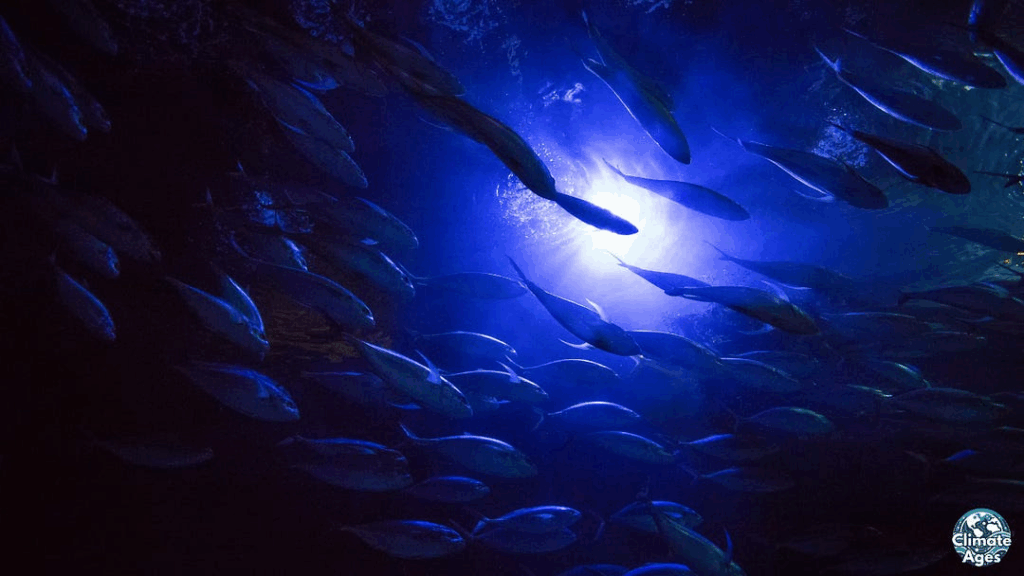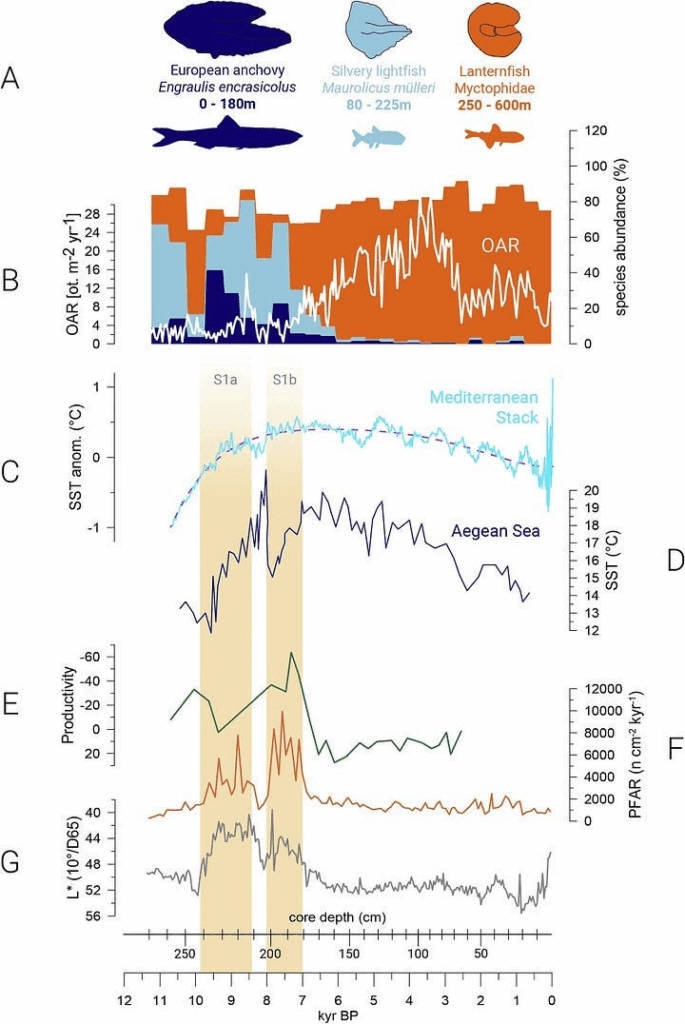The main purpose of this ongoing blog will be to track planetary extreme, or record temperatures related to climate change. Any reports I see of ETs will be listed below the main topic of the day. I’ll refer to record temperatures as ETs (not extraterrestrials).😜
Main Topic: What Lanternfish Fossils Teach Us About the Future of Our Oceans
Dear Diary. It makes perfect sense that the fossil record holds clues about Earth’s past when our climate changed relatively abruptly. By abruptly I mean over the space of a couple of thousand years, not now over just s couple of hundred. Deep sea organisms are affected by carbon content of the Earth’s oceans, as well as salinity, oxygen, and temperature.
Fossilized remnants of tiny fish hold clues about how climate changed during past eons and can give us another warning about what will happen if we continue to spew carbon into the atmosphere from the burning of fossil fuels. Here are many more details from Climate Ages:
What Lanternfish Fossils Teach Us About the Future of Our Oceans
A new study reveals what happens when the ocean loses its breath and why tiny fish in the deep sea matter more than you think
| Silvia Pineda-Munoz PhD Aug 1, 2025 |


Image from CANVA
So much of what sustains life doesn’t leave a mark. Air doesn’t fossilize. But its absence? That shows up loud and clear.
I’ve spent most of my career studying ancient mammals, but lately, I’ve been working more closely with conservation organizations. That shift has made me pay closer attention to how lessons from one group, like deep-sea fish, can guide our understanding of broader ecosystem collapse.
Climate Ages is a reader-supported publication. To receive new posts and support my work, consider becoming a free or paid subscriber.
It’s easy to ignore what’s out of sight, especially the deep ocean. But a new study just made that impossible.
A team of researchers led by Sven Pallacks at the Universitat Autònoma de Barcelona (one of my Alma Mater) studied fossil fish remains from the Aegean Sea to reconstruct how marine ecosystems responded to ancient oxygen loss. They focused on lanternfish, tiny, glowing creatures that make up one of the largest biomasses of any vertebrate group on Earth.
These fish live in the so-called “twilight zone” of the ocean, 200–1,000 meters below the surface, and perform daily vertical migrations to feed. In doing so, they transport carbon from the surface to the deep, quietly stabilizing our climate in the background.

Ecological response of fish to changing oceanographic conditions during the Holocene in the central western Aegean Sea. A High mesopelagic fish production in a well-ventilated water column during the Late Holocene. B Enhanced/low epipelagic/mesopelagic fish production under expanded ocean hypoxia during Sapropel deposition. C Ocean data view bathymetry map of study area and core locations of M144 KC5–6 (this study) and SK1 — Pallacks et al., 2025
But here’s something important: in sediment cores that cover more than 11,000 years of ocean history, lanternfish almost disappeared during a time when the ocean lost its breath, an event known as the Sapropel S1 period, which occurred between 7,000 and 10,000 years ago. Once oxygen returned, the lanternfish came back in force.
“If a group with such massive biomass disappears, other marine species are also likely to be at risk,” Dr. Pallacks warned.
That isn’t just a story about the past. It’s a warning about the future.
To uncover this pattern, the team analyzed otoliths, tiny inner ear bones from fish, preserved in deep-sea sediment from a core collected 559 meters below the surface in the Aegean Sea. These bones are excellent timekeepers; they accumulate layer by layer, like tree rings, and when buried in sediment, they can last thousands of years.
The researchers sorted through over 3,200 otoliths and identified species-level changes in fish communities during different time windows. Then they compared those shifts to known periods of ocean deoxygenation, temperature change, and productivity. The method is technical, but the idea is simple: look at who lived, who didn’t, and what the water was like when those changes happened.
During the low-oxygen phase known as Sapropel S1, lanternfish, typically dominant in these waters, plummeted in number. They made up only 14% of the fossil record at the time, compared to up to 91% in later, better-oxygenated layers. Other fish, like the silvery lightfish and European anchovy, filled the gap. These species live closer to the surface, where oxygen is still available, and they can take advantage of the productive upper waters.
But even though surface productivity was high (plankton were blooming, food was available), lanternfish couldn’t survive the lack of oxygen at depth. Their daytime refuge had become hostile.

This pattern matched what we’re already seeing today in parts of the modern ocean. As oxygen minimum zones (OMZs) expand due to warming and stratification, the habitat for mesopelagic fish compresses vertically. They get squeezed between predators at the surface and suffocating water below. It’s like trying to live in a house where the ceiling gets lower every day.
And if lanternfish go, the ripple effects would be enormous. These fish are not just food for larger predators; they’re also key players in the ocean’s carbon cycle. When they migrate, they carry carbon with them, helping sequester it in deep waters. Without them, less carbon gets stored, and more remains in the atmosphere.
What struck me most about this study wasn’t just the scale of the decline. It was the reminder that ecosystems don’t break all at once. They start with a subtle shift; oxygen dipping just enough to push one group out of its comfort zone. A few species rise while others fall.
Sometimes, those shifts are reversible. The lanternfish bounced back once the ocean re-oxygenated. But our current trajectory isn’t one of natural recovery. It’s one of acceleration.
As someone who’s spent years reconstructing ancient climates from bones and teeth, I’ve learned to trust the sediment. It doesn’t lie. And what it’s telling us now is this: we’ve seen this pattern before, and it didn’t end well.
The deep ocean might seem like a world apart, but it’s not. It connects to everything: from the plankton at the surface to the whales above and, ultimately, to us. The air we breathe, the climate we depend on, and the fisheries millions rely on are all linked to the quiet lives of fish we barely know.
We often think of extinction in terms of charismatic megafauna. But sometimes, the canary in the coal mine is a glowing, thumb-sized fish that never even makes it to the surface.
Thank you for supporting independent science writing! Your support helps keep these stories free for everyone, spreading science, trust, and action. I couldn’t do this without you!
If you enjoy my work and want to help me keep these stories free for everyone, I’d appreciate your support at any level that’s comfortable for you:
 $1/month or $10/year – A small boost with a big impact.
$1/month or $10/year – A small boost with a big impact.
 $2/month or $20/year – Supporting science communication.
$2/month or $20/year – Supporting science communication.
 $3/month or $30/year – Investing in evidence-based insights.
$3/month or $30/year – Investing in evidence-based insights.
 $4/month or $40/year – Expanding science for everyone.
$4/month or $40/year – Expanding science for everyone.
 $5/month or $50/year – Powering independent science writing.
$5/month or $50/year – Powering independent science writing.
Every contribution helps me continue creating content that makes science accessible, engaging, and impactful.
With Love,
Silvia P-M, PhD — Climate Ages
Here are more “ET’s” recorded from around the planet the last couple of days, their consequences, and some extreme temperature outlooks, as well as any extreme precipitation reports:
Here is More Climate News from Saturday:
(As usual, this will be a fluid post in which more information gets added during the day as it crosses my radar, crediting all who have put it on-line. Items will be archived on this site for posterity. In most instances click on the pictures of each tweet to see each article. The most noteworthy items will be listed first.)